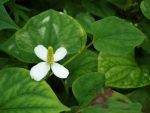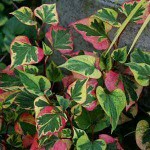 Native to Southeast Asia, this herbaceous perennial is known by many names including fish mint, rainbow plant, heart leaf and Chinese lizard tail. A member of the lizard-tail family, Saururaceae, it has a rapid creeping habit that makes it a potential weed and invasive plant. Growing 1-2′ tall, chamleon plant has trailing, smooth, red-tinged stems that produce adventitious roots on one end while growing upright and producing leaves and flowers on the other. The alternate blue-green leaves are 1-3″ long, heart shaped, and aromatic when crushed. In early summer tiny greenish-yellow flowers appear in terminal spikes about 1″ long and are surrounded by 4 large petal-like white bracts. The stems and leaves are edible and eaten especially by people in China and Vietnam who appreciate the peppery, fishy taste. In addition, the plant is used in traditional Chinese medicine. The species is not often seen in US gardens but the cultivar ‘Chamelieon’ is popular for its red, pink, yellow and cream variegated leaves and bright red stems. It is often used as a ground cover in moist areas but can also be used in a bog garden or pond edges. The genus name, Houttuynia, honors the Dutch naturalist, Maarten Houttuyn or Houttuijn (1720 – 1798). The specific epithet, cordata, is the Latin word meaning heart-shaped, and refers to the leaves. Photo Credit Wikipedia
Native to Southeast Asia, this herbaceous perennial is known by many names including fish mint, rainbow plant, heart leaf and Chinese lizard tail. A member of the lizard-tail family, Saururaceae, it has a rapid creeping habit that makes it a potential weed and invasive plant. Growing 1-2′ tall, chamleon plant has trailing, smooth, red-tinged stems that produce adventitious roots on one end while growing upright and producing leaves and flowers on the other. The alternate blue-green leaves are 1-3″ long, heart shaped, and aromatic when crushed. In early summer tiny greenish-yellow flowers appear in terminal spikes about 1″ long and are surrounded by 4 large petal-like white bracts. The stems and leaves are edible and eaten especially by people in China and Vietnam who appreciate the peppery, fishy taste. In addition, the plant is used in traditional Chinese medicine. The species is not often seen in US gardens but the cultivar ‘Chamelieon’ is popular for its red, pink, yellow and cream variegated leaves and bright red stems. It is often used as a ground cover in moist areas but can also be used in a bog garden or pond edges. The genus name, Houttuynia, honors the Dutch naturalist, Maarten Houttuyn or Houttuijn (1720 – 1798). The specific epithet, cordata, is the Latin word meaning heart-shaped, and refers to the leaves. Photo Credit Wikipedia

Type: Herbaceous perennial
Bloom: Spikes of tiny greenish-white flowers in summer
Size: 1-2′ H x indefinate spread
Light: Full sun to part shade; tolerates deep shade.
Soil: Organically rich, consistently moist to wet, up to 2″ of water over crown
Hardiness: Zones 4-10
Care: Plant in a container to prevent aggressive spreading.
Pests and Diseases: None of significance but aphids and slugs can be a problem.
Propagation: Division
Companion Plants: Variegated sweet flag, blue flag, water arum, marsh marigold, canna lily
Outstanding Selections:
‘Chameleon’ (aka Tricolor, Variegata and’ Court Jester;’ red stems with red, pink, yellow, cream variegated leaves)
“Flora Plena’ (many white bracts)
Photo Credit: Wikipedia